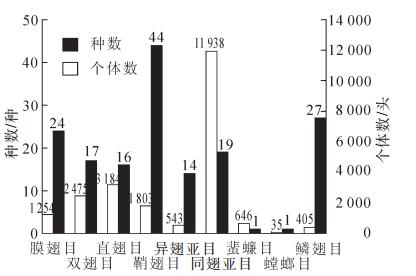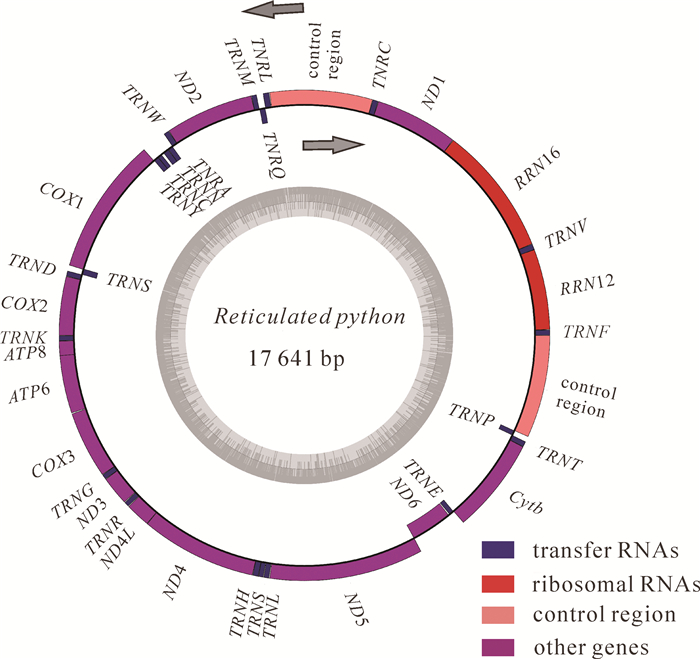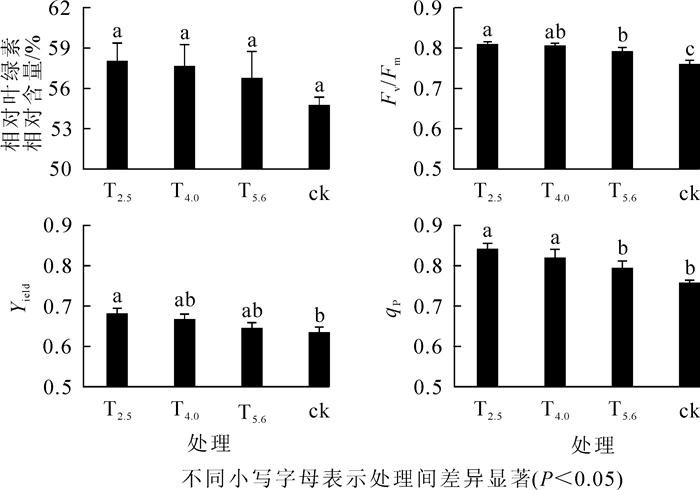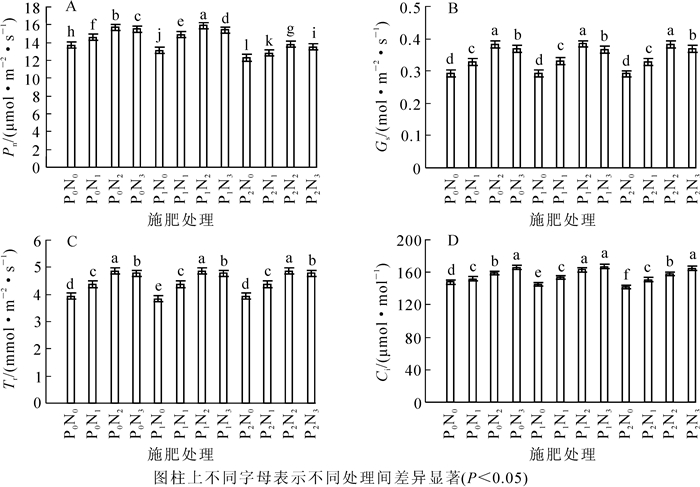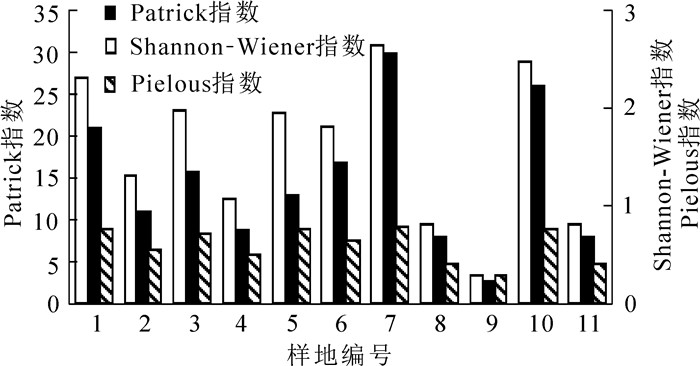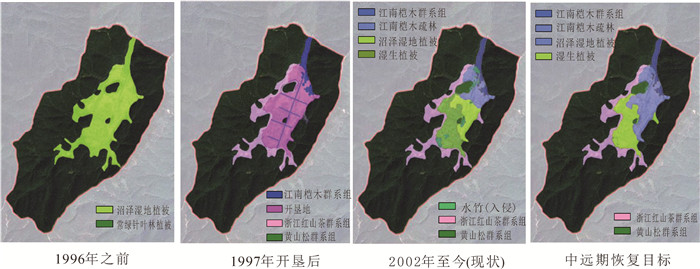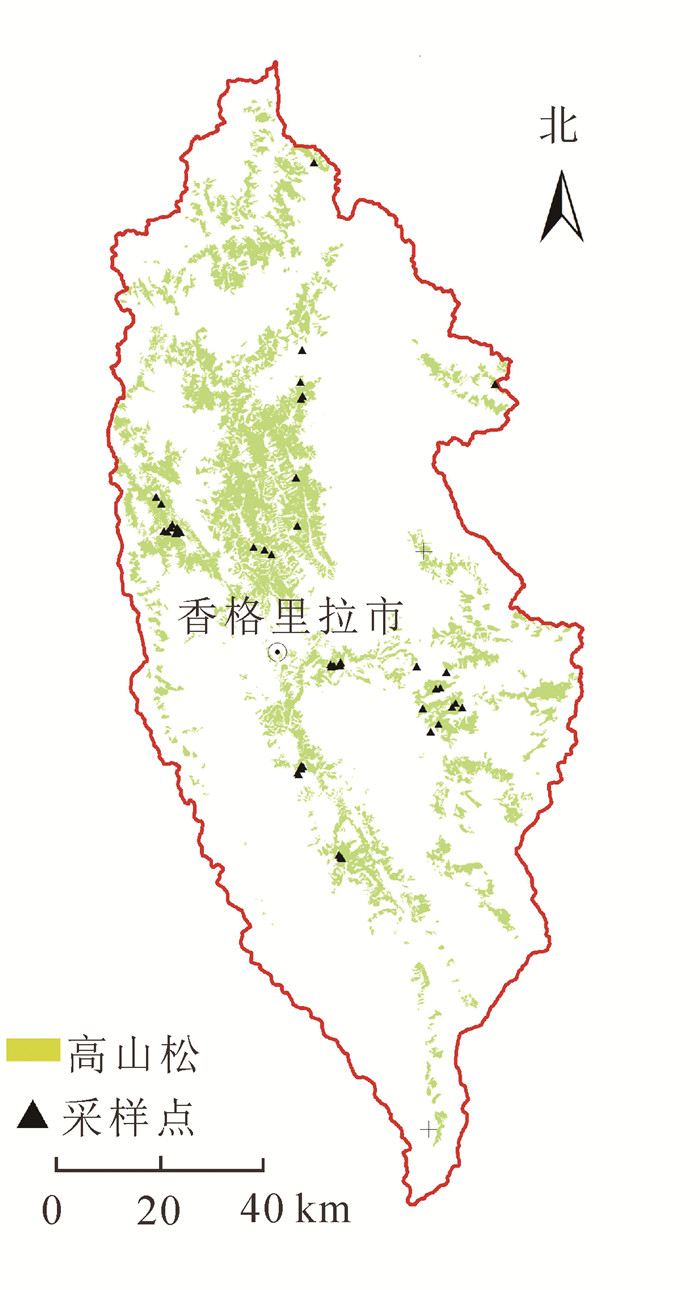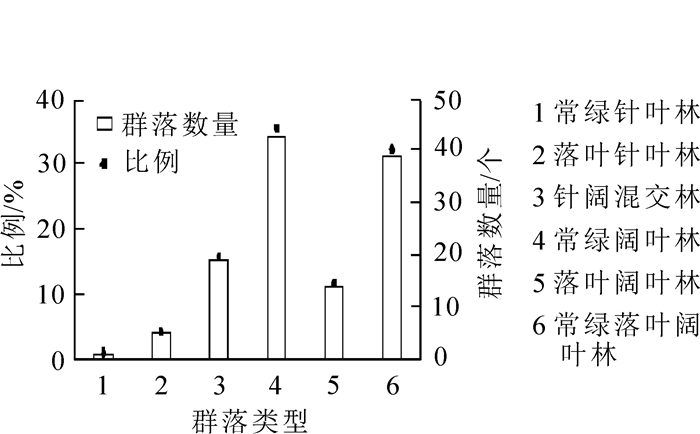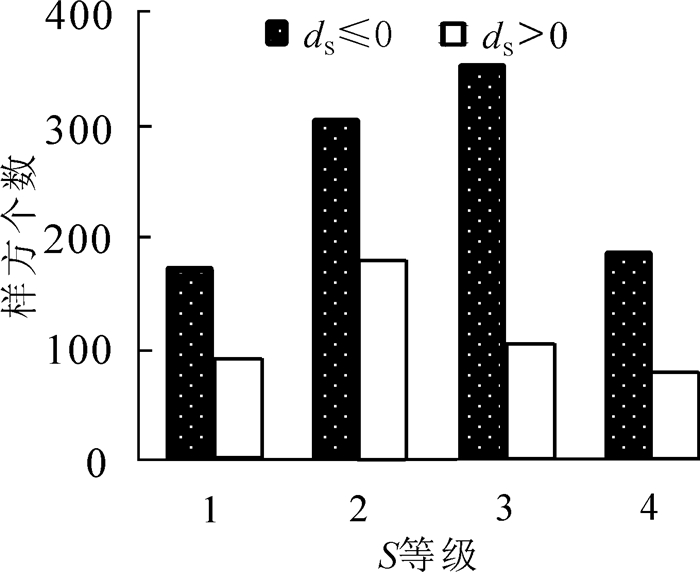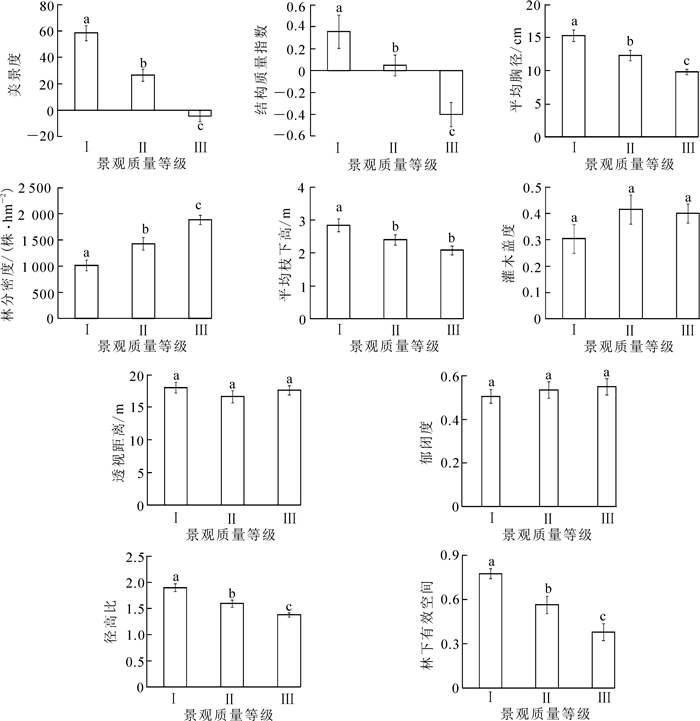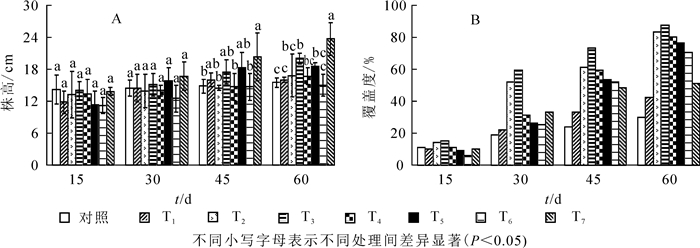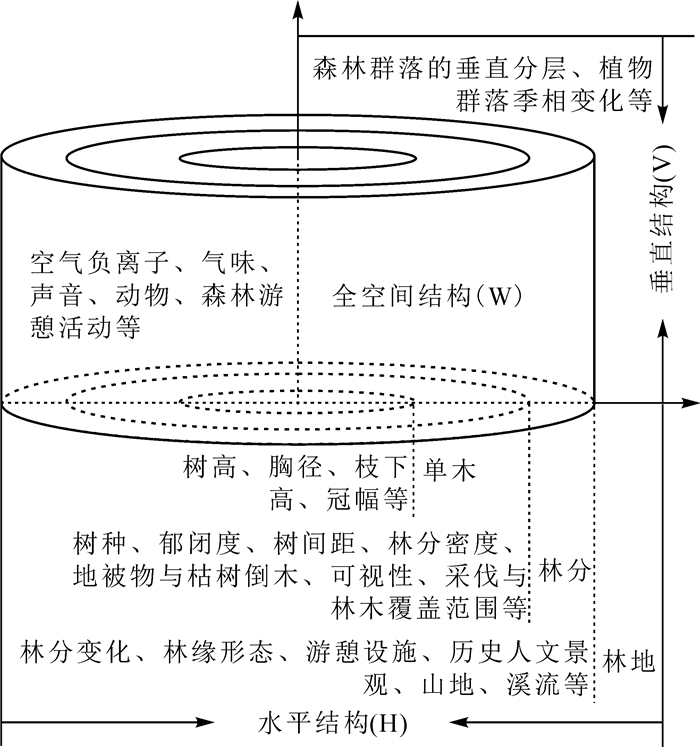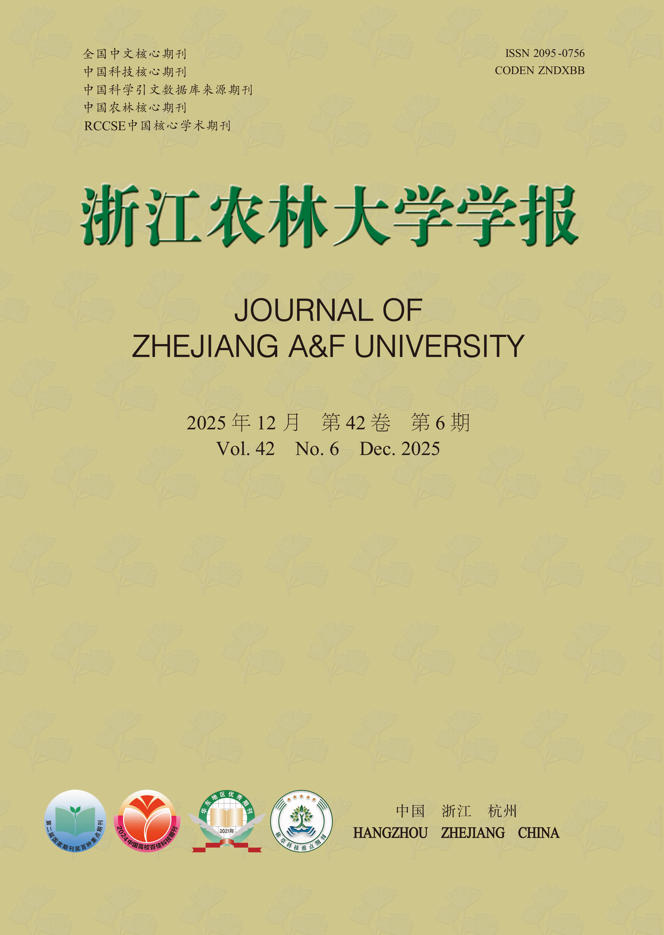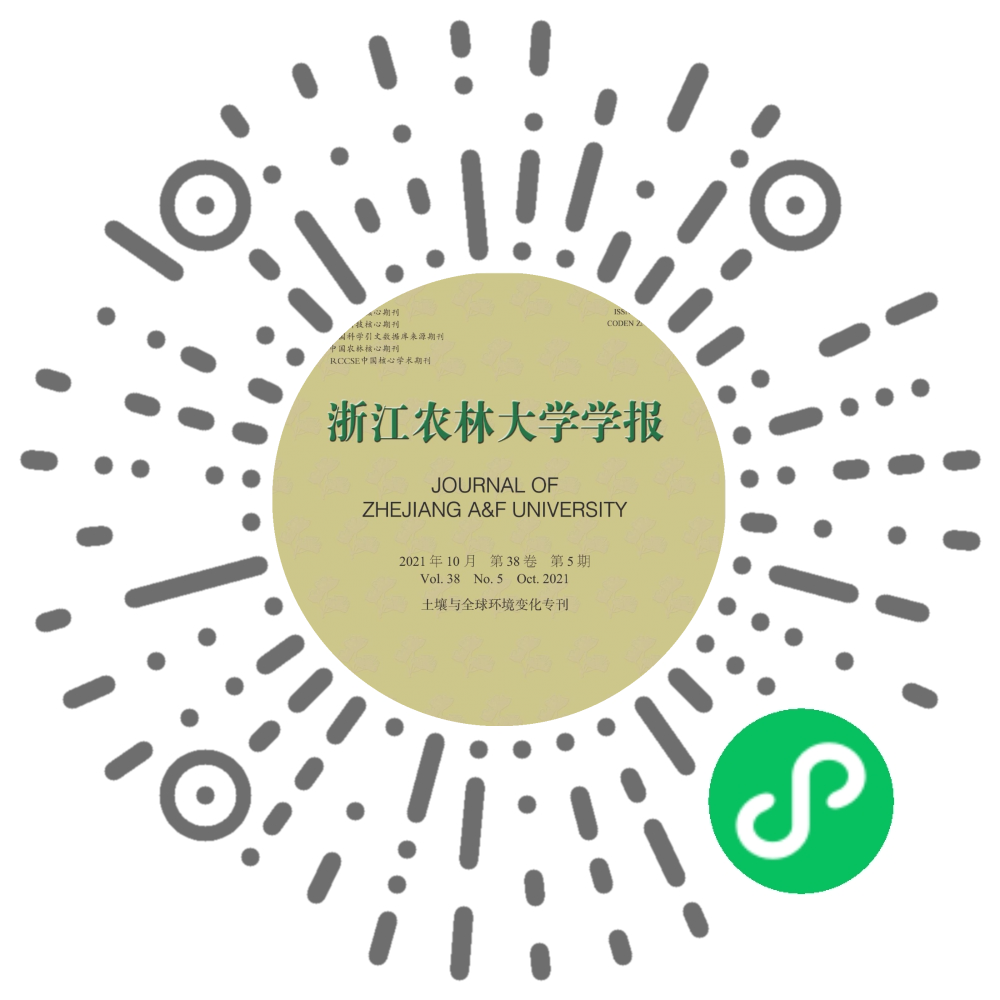2019 Vol. 36, No. 3
2019, 36(3): 429-436.
doi: 10.11833/j.issn.2095-0756.2019.03.001
Abstract:
To provide opinions and suggestions for management of Carya cathayensis forests, this research analyzed differences in insect communities using four different management modes:Type Ⅰ-a wild C. cathayensis forest, Type Ⅱ-vegetation planted under a C. cathayensis forest, Type Ⅲ-a traditional C. cathayensis forest, and Type Ⅳ-an organically managed C. cathayensis forest. Methods of collecting insect specimens included Malaise trap, light lure, and quadrat survey. Characteristic indexes of diversity, stability of insect community, principal components, and similarity were calculated and analyzed using Excel 2013 and SPSS 19.0 software. Results showed a total of 22 283 insect specimens being collected belonging to 163 species, 84 families, and 9 orders. Coleoptera and Hymenoptera were dominant groups for species numbers; whereas, Homoptera and Orthoptera were dominant groups for individual numbers. For the entire insect community the best performance was with management Type Ⅰ, the wild C. cathayensis forest, with a diversity index of 3.64 and an evenness index of 0.74. For Type Ⅱ, the diversity index was 3.12, and the evenness index was 0.61; this forest management type had good performance. For the insect communities in Malaise traps, the individual number and species number with Type Ⅱ management were significantly higher than the other management types (P < 0.05). The diversity index and the evenness index for Type Ⅰ and Type Ⅱ management were not significantly different but were significantly higher than other management types (P < 0.05). The dominance index with Type Ⅲ management was significantly higher than other management types (P < 0.05). For community structure, the Sn/Sp ratio for Type Ⅳ management was best with 0.39 meaning that the complexity and mutual restriction ability of the food network in the community was high. The St/Si ratio of the wild C. cathayensis forest was best with 0.04 meaning the mutual restriction of species number was stronger. The principal component analysis showed differences for different management modes. Also the dominant factors for changes in the insect communities were different. A similarity analysis found that when the measure was five, insect community structures were similar for Type Ⅱ and Type Ⅳ management. Overall, the ecological structure of the wild C. cathayensis forest (Type Ⅰ management) was most stable followed by Type Ⅱ, and because inefficient use of a C. cathayensis forest was forbidden in the actual production process, the management mode of vegetation planted under a C. cathayensis forest (Type Ⅱ) was recommended for farmers.
To provide opinions and suggestions for management of Carya cathayensis forests, this research analyzed differences in insect communities using four different management modes:Type Ⅰ-a wild C. cathayensis forest, Type Ⅱ-vegetation planted under a C. cathayensis forest, Type Ⅲ-a traditional C. cathayensis forest, and Type Ⅳ-an organically managed C. cathayensis forest. Methods of collecting insect specimens included Malaise trap, light lure, and quadrat survey. Characteristic indexes of diversity, stability of insect community, principal components, and similarity were calculated and analyzed using Excel 2013 and SPSS 19.0 software. Results showed a total of 22 283 insect specimens being collected belonging to 163 species, 84 families, and 9 orders. Coleoptera and Hymenoptera were dominant groups for species numbers; whereas, Homoptera and Orthoptera were dominant groups for individual numbers. For the entire insect community the best performance was with management Type Ⅰ, the wild C. cathayensis forest, with a diversity index of 3.64 and an evenness index of 0.74. For Type Ⅱ, the diversity index was 3.12, and the evenness index was 0.61; this forest management type had good performance. For the insect communities in Malaise traps, the individual number and species number with Type Ⅱ management were significantly higher than the other management types (P < 0.05). The diversity index and the evenness index for Type Ⅰ and Type Ⅱ management were not significantly different but were significantly higher than other management types (P < 0.05). The dominance index with Type Ⅲ management was significantly higher than other management types (P < 0.05). For community structure, the Sn/Sp ratio for Type Ⅳ management was best with 0.39 meaning that the complexity and mutual restriction ability of the food network in the community was high. The St/Si ratio of the wild C. cathayensis forest was best with 0.04 meaning the mutual restriction of species number was stronger. The principal component analysis showed differences for different management modes. Also the dominant factors for changes in the insect communities were different. A similarity analysis found that when the measure was five, insect community structures were similar for Type Ⅱ and Type Ⅳ management. Overall, the ecological structure of the wild C. cathayensis forest (Type Ⅰ management) was most stable followed by Type Ⅱ, and because inefficient use of a C. cathayensis forest was forbidden in the actual production process, the management mode of vegetation planted under a C. cathayensis forest (Type Ⅱ) was recommended for farmers.
2019, 36(3): 437-443.
doi: 10.11833/j.issn.2095-0756.2019.03.002
Abstract:
To explore the volatiles from the Carya cathayensis, which affect the behavioral response of the brown mulberry longhorn beetle, Batocera horsfieldi, and to provide a theoretical basis for screening plant-originated attractants or repellents of this insect. In the C. cathayensis of Lin'an Yayuan Village, 3 C. cathayensis trees were vandamly selected from different damaged states[healthy (ck), as well as feeding, oviposition and boring damage by longicorn beetle]. The volatiles were collected by using dynamic headspace adsorption living plants, and those causing electrophysiological and behavioral responses in B. horsfieldi were identified by gas chromatography-electrophysiological antennal detecting system (GC-EAD) and Y-tube olfactometer. Results showed that the B. horsfieldi adults had significant electrophysiological responses to eight volatiles of C. cathayensis volatiles with different damaged states, including (1R)-(+)-alpha-pinene, g-terpinene, nonanal, α-terpineol, pentamethyl phenyl, 2-ethylhexyl acrylate, 2, 6-dimethylnaphthalene and hexadecane. Female and male adults had the strongest electrophysiological responses to nonanal and α-terpineol followed. The olfactory reaction showed that g-terpinene had a significant attractivity to male adults of B. horsfieldi (P < 0.05). Also nonanal had an highly significant attractivity to female adults (P < 0.01) and a significant attractivity to male adults (P < 0.05). Meanwhlie, (1R)-(+)-alpha-pinene had an highly significant repellent activity to female adults (P < 0.01). In addition α-terpineol had a highly significant attractivity to female adults (P < 0.01), but a significant repellent activity to male adults (P < 0.05). These results indicate that α-terpineol and nonanal showed strong attractivity to female adults of B. horsfieldi, while (1R)-(+)-alpha-pinene showed good repellent activity, g-terpinene and nonanal showed strong attractivity to male adults, while α-terpineol showed good repellent activity.
To explore the volatiles from the Carya cathayensis, which affect the behavioral response of the brown mulberry longhorn beetle, Batocera horsfieldi, and to provide a theoretical basis for screening plant-originated attractants or repellents of this insect. In the C. cathayensis of Lin'an Yayuan Village, 3 C. cathayensis trees were vandamly selected from different damaged states[healthy (ck), as well as feeding, oviposition and boring damage by longicorn beetle]. The volatiles were collected by using dynamic headspace adsorption living plants, and those causing electrophysiological and behavioral responses in B. horsfieldi were identified by gas chromatography-electrophysiological antennal detecting system (GC-EAD) and Y-tube olfactometer. Results showed that the B. horsfieldi adults had significant electrophysiological responses to eight volatiles of C. cathayensis volatiles with different damaged states, including (1R)-(+)-alpha-pinene, g-terpinene, nonanal, α-terpineol, pentamethyl phenyl, 2-ethylhexyl acrylate, 2, 6-dimethylnaphthalene and hexadecane. Female and male adults had the strongest electrophysiological responses to nonanal and α-terpineol followed. The olfactory reaction showed that g-terpinene had a significant attractivity to male adults of B. horsfieldi (P < 0.05). Also nonanal had an highly significant attractivity to female adults (P < 0.01) and a significant attractivity to male adults (P < 0.05). Meanwhlie, (1R)-(+)-alpha-pinene had an highly significant repellent activity to female adults (P < 0.01). In addition α-terpineol had a highly significant attractivity to female adults (P < 0.01), but a significant repellent activity to male adults (P < 0.05). These results indicate that α-terpineol and nonanal showed strong attractivity to female adults of B. horsfieldi, while (1R)-(+)-alpha-pinene showed good repellent activity, g-terpinene and nonanal showed strong attractivity to male adults, while α-terpineol showed good repellent activity.
2019, 36(3): 444-450.
doi: 10.11833/j.issn.2095-0756.2019.03.003
Abstract:
To explore the possibility of non-invasive sampling in snake research, feces and fresh snake sloughs for genome extraction from Python reticulatus (reticulated python) were used. Furthermore, Polymerase Chain Reaction (PCR) was taken, and the full sequence of mitochondrial genome was analyzed with mitochondrial genome dates in GenBank. Results showed that (1) the quality of DNA extracted from snake sloughs was better than that of feces, and the concentration of DNA extracted by liquid nitrogen treatment was higher. (2) The complete sequence of the mitochondrial genome was obtained for a length of 17 641 bp with gene arrangement and structure being consistent with the Pythonidae species. However, there were differences in the start codons and stop codons of some genes. (3) Inferred from the phylogenetic tree analysis, the evolutionary relationship was speculated as (Pythonidae, Xenopeltidae and Boidae). (4) Analysis of the hotspots in species evolution showed that similarity was very high in the two control regions, and they were clustered by species in the phylogenetic tree. Thus, it was presumed the structures of the two control regions originated from the same ancestor, and this intraspecific evolution was due to co-evolution.
To explore the possibility of non-invasive sampling in snake research, feces and fresh snake sloughs for genome extraction from Python reticulatus (reticulated python) were used. Furthermore, Polymerase Chain Reaction (PCR) was taken, and the full sequence of mitochondrial genome was analyzed with mitochondrial genome dates in GenBank. Results showed that (1) the quality of DNA extracted from snake sloughs was better than that of feces, and the concentration of DNA extracted by liquid nitrogen treatment was higher. (2) The complete sequence of the mitochondrial genome was obtained for a length of 17 641 bp with gene arrangement and structure being consistent with the Pythonidae species. However, there were differences in the start codons and stop codons of some genes. (3) Inferred from the phylogenetic tree analysis, the evolutionary relationship was speculated as (Pythonidae, Xenopeltidae and Boidae). (4) Analysis of the hotspots in species evolution showed that similarity was very high in the two control regions, and they were clustered by species in the phylogenetic tree. Thus, it was presumed the structures of the two control regions originated from the same ancestor, and this intraspecific evolution was due to co-evolution.
2019, 36(3): 451-458.
doi: 10.11833/j.issn.2095-0756.2019.03.004
Abstract:
To find the effects of chlorophyll parameters and biomass of Elaeocarpus glabripetalus seedlings and the absorption of soil elements for different levels of acidity, a simulated acid rain spray test with three acidity levels[pH 2.5 (severe acid rain), pH 4.0 (moderate acid), and pH 5.6 (mild acid rain)], as well as a control group (ck) was used. Results showed that the chlorophyll parameters of E. glabripetalus seedlings increased with a decrease in the pH of acid rain. The relative chlorophyll content (SPAD) in each treatment group was higher than the control group. The maximum chemical quantum yield (Fv/Fm) increased with a decrease in pH of acid rain, and there was a significant difference between the treatment groups and ck (P < 0.05). The leaf nitrogen (N) mass fraction of each treatment group was not significantly different from ck (P>0.05). The phosphorus (P) mass fraction for the heavy and mild acid rain group was significantly lower than ck (P>0.05). Seedlings in the upper part of the mass fraction and transfer coefficients of heavy and moderate acid groups were higher than ck. The zinc (Zn) transfer coefficients and enrichment coefficients of each treatment group were significantly higher than ck (P < 0.05). Based on the comprehensive analysis, acid rain increased the chlorophyll content of seedlings, and improved the photosynthetic capacity of seedlings. Acid rain also promoted the redistribution of seedlings biomass, making the root system more robust, thus promoting the absorption of mineral elements in the roots and enhancing the plant's resistance to environmental stress. In addition, acid rain increased the Zn transfer coefficient of roots thereby increasing the tolerance of seedlings to heavy metal Zn. Overall, this study provided a scientific basis for nutrient distribution characteristics and physiological response mechanism of Elaeocarpus glabripetalus seedlings with acid rain stress.
To find the effects of chlorophyll parameters and biomass of Elaeocarpus glabripetalus seedlings and the absorption of soil elements for different levels of acidity, a simulated acid rain spray test with three acidity levels[pH 2.5 (severe acid rain), pH 4.0 (moderate acid), and pH 5.6 (mild acid rain)], as well as a control group (ck) was used. Results showed that the chlorophyll parameters of E. glabripetalus seedlings increased with a decrease in the pH of acid rain. The relative chlorophyll content (SPAD) in each treatment group was higher than the control group. The maximum chemical quantum yield (Fv/Fm) increased with a decrease in pH of acid rain, and there was a significant difference between the treatment groups and ck (P < 0.05). The leaf nitrogen (N) mass fraction of each treatment group was not significantly different from ck (P>0.05). The phosphorus (P) mass fraction for the heavy and mild acid rain group was significantly lower than ck (P>0.05). Seedlings in the upper part of the mass fraction and transfer coefficients of heavy and moderate acid groups were higher than ck. The zinc (Zn) transfer coefficients and enrichment coefficients of each treatment group were significantly higher than ck (P < 0.05). Based on the comprehensive analysis, acid rain increased the chlorophyll content of seedlings, and improved the photosynthetic capacity of seedlings. Acid rain also promoted the redistribution of seedlings biomass, making the root system more robust, thus promoting the absorption of mineral elements in the roots and enhancing the plant's resistance to environmental stress. In addition, acid rain increased the Zn transfer coefficient of roots thereby increasing the tolerance of seedlings to heavy metal Zn. Overall, this study provided a scientific basis for nutrient distribution characteristics and physiological response mechanism of Elaeocarpus glabripetalus seedlings with acid rain stress.
2019, 36(3): 459-467.
doi: 10.11833/j.issn.2095-0756.2019.03.005
Abstract:
To ascertain the effects of nitrogen (N) and phosphorus (P), key nutrients during plant growth, on Correa carmen, twelve gradient fertilization experiments were designed, and the photosynthetic physiological parameters and chlorophyll fluorescence parameters of C. carmen leaves were determined. The seedlings of C. carmen were planted in pots with different amount of N fertilizer (NH4NO3) and P fertilizer (NaH2PO4·2H2O). P fertilizer doses (calculated by PO43-) were 0, 36.3, 56.3 mg·kg-1, respectively. N fertilizer doses (calculated by N) were 0, 197.9, 247.9 and 297.9 mg·kg-1, respectively. After 1 month, 4 months and 7 months respectively, the photosynthetic physiological parameters of seedling leaves were measured by the CIRAS-3 portable photosynthesis system, such as net photosynthetic rate (Pn), stomatal conductance (Gs), transpiration rate (Tr), etc. At the same time, chlorophyll fluorescence parameters were measured by imaging modulation PAM-2500 chlorophyll fluorescence spectrometer, too, such as initial fluorescence (Fo), maximum fluorescence (Fm), maximum photochemical efficiency (Fv/Fm), photochemical quenching coefficient (qP), non-photochemical quenching coefficient (qNP), etc. Then N and P contents of leaves were determined by Kjeldahl method and Molybdenum antimony anti-absorption spectrophotometry method, chlorophyll contents were determined by acetone and ethanol mixture extraction method. The variation of experimental data was analyzed by ANOVA and multiple comparison, and the multiple comparison was analyzed by the least significant difference method (LSD). Results showed that (1) with added P fertilizer alone, the photosynthetic efficiency indexes of C. carmen leaves including chlorophyll content, Pn, and Fv/Fm decreased (P < 0.05), but light dissipation indexes including F0 and non-photochemical quenching (qNP) extinction coefficient increased (P < 0.05). (2) With added N fertilizer alone, as dose increased to 247.9 mg·kg-1, photosynthetic efficiency indexes increased (P < 0.05) but decreased (P < 0.05) as the dose exceed it. The light dissipation index showed the opposite trend. (3) The application effect of P fertilizer increased with an increase dose of N fertilizer, and the application effect of N fertilizer increased (P < 0.05) first and then decreased (P < 0.05) with an increased dose of P fertilizer. With less N fertilizer but more P fertilizer or with less P fertilizer but more N fertilizer, the photosynthetic efficiency of C. carmen leaves decreased significantly (P < 0.01). Photosynthetic efficiency indexes were highest when N fertilizer dose was 247.9 mg·kg-1 and P fertilizer dose was 36.3 mg·kg-1. Thus, C. carmen was sensitive to P with a low demand, and when adding P fertilizer to low-N soils, the photosynthesis efficiency indexes of C. carmen decreased, but when both N fertilizer and P fertilizers were added, they increased greatly.
To ascertain the effects of nitrogen (N) and phosphorus (P), key nutrients during plant growth, on Correa carmen, twelve gradient fertilization experiments were designed, and the photosynthetic physiological parameters and chlorophyll fluorescence parameters of C. carmen leaves were determined. The seedlings of C. carmen were planted in pots with different amount of N fertilizer (NH4NO3) and P fertilizer (NaH2PO4·2H2O). P fertilizer doses (calculated by PO43-) were 0, 36.3, 56.3 mg·kg-1, respectively. N fertilizer doses (calculated by N) were 0, 197.9, 247.9 and 297.9 mg·kg-1, respectively. After 1 month, 4 months and 7 months respectively, the photosynthetic physiological parameters of seedling leaves were measured by the CIRAS-3 portable photosynthesis system, such as net photosynthetic rate (Pn), stomatal conductance (Gs), transpiration rate (Tr), etc. At the same time, chlorophyll fluorescence parameters were measured by imaging modulation PAM-2500 chlorophyll fluorescence spectrometer, too, such as initial fluorescence (Fo), maximum fluorescence (Fm), maximum photochemical efficiency (Fv/Fm), photochemical quenching coefficient (qP), non-photochemical quenching coefficient (qNP), etc. Then N and P contents of leaves were determined by Kjeldahl method and Molybdenum antimony anti-absorption spectrophotometry method, chlorophyll contents were determined by acetone and ethanol mixture extraction method. The variation of experimental data was analyzed by ANOVA and multiple comparison, and the multiple comparison was analyzed by the least significant difference method (LSD). Results showed that (1) with added P fertilizer alone, the photosynthetic efficiency indexes of C. carmen leaves including chlorophyll content, Pn, and Fv/Fm decreased (P < 0.05), but light dissipation indexes including F0 and non-photochemical quenching (qNP) extinction coefficient increased (P < 0.05). (2) With added N fertilizer alone, as dose increased to 247.9 mg·kg-1, photosynthetic efficiency indexes increased (P < 0.05) but decreased (P < 0.05) as the dose exceed it. The light dissipation index showed the opposite trend. (3) The application effect of P fertilizer increased with an increase dose of N fertilizer, and the application effect of N fertilizer increased (P < 0.05) first and then decreased (P < 0.05) with an increased dose of P fertilizer. With less N fertilizer but more P fertilizer or with less P fertilizer but more N fertilizer, the photosynthetic efficiency of C. carmen leaves decreased significantly (P < 0.01). Photosynthetic efficiency indexes were highest when N fertilizer dose was 247.9 mg·kg-1 and P fertilizer dose was 36.3 mg·kg-1. Thus, C. carmen was sensitive to P with a low demand, and when adding P fertilizer to low-N soils, the photosynthesis efficiency indexes of C. carmen decreased, but when both N fertilizer and P fertilizers were added, they increased greatly.
2019, 36(3): 468-478.
doi: 10.11833/j.issn.2095-0756.2019.03.006
Abstract:
In hickory (Carya cathayensis), an important non-timber species in Zhejiang Province, the existence of apomixis, of imprinted quantitative trait loci (iQTLs), and of low DNA polymorphism in terms of cytobiology and molecular markers, has recently been found. Since iQTLs (related to DNA methylation, an inheritable biological phenomenon) played a vital role in epigenetic regulation, methylation-sensitive amplified polymorphism (MSAP), a Polymerase Chain Reaction (PCR)-based method of detecting DNA methylation, was used to establish a protocol in hickory. Then samples from three natural hickory populations were analyzed. Results showed that methylation was prevalent in hickory with the non-methylation level significantly higher (Wilcoxon signed-rank test, P < 0.001) than the total methylation level. Internal cytosine methylation had a relatively higher level than semi-methylation, both of which were also significantly different from each other (Analysis of molecular variance (AMOVA) followed by Duncan's multiple comparison, P < 0.001). If hickory populations had a high level of internal cytosine methylation, then levels of semi-methylation and non-methylation of these populations were relatively low, and vice versa. Also, there was epigenetic differentiation among hickory populations, and the main differentiation existed within a population. In conclusion, this work has laid a foundation for further study of methylation in hickory; in fact, the MSAP protocol established in hickory could be used for pecan, even though the loci and the number of loci for pecan were different from those of hickory.
In hickory (Carya cathayensis), an important non-timber species in Zhejiang Province, the existence of apomixis, of imprinted quantitative trait loci (iQTLs), and of low DNA polymorphism in terms of cytobiology and molecular markers, has recently been found. Since iQTLs (related to DNA methylation, an inheritable biological phenomenon) played a vital role in epigenetic regulation, methylation-sensitive amplified polymorphism (MSAP), a Polymerase Chain Reaction (PCR)-based method of detecting DNA methylation, was used to establish a protocol in hickory. Then samples from three natural hickory populations were analyzed. Results showed that methylation was prevalent in hickory with the non-methylation level significantly higher (Wilcoxon signed-rank test, P < 0.001) than the total methylation level. Internal cytosine methylation had a relatively higher level than semi-methylation, both of which were also significantly different from each other (Analysis of molecular variance (AMOVA) followed by Duncan's multiple comparison, P < 0.001). If hickory populations had a high level of internal cytosine methylation, then levels of semi-methylation and non-methylation of these populations were relatively low, and vice versa. Also, there was epigenetic differentiation among hickory populations, and the main differentiation existed within a population. In conclusion, this work has laid a foundation for further study of methylation in hickory; in fact, the MSAP protocol established in hickory could be used for pecan, even though the loci and the number of loci for pecan were different from those of hickory.
2019, 36(3): 479-485.
doi: 10.11833/j.issn.2095-0756.2019.03.007
Abstract:
To study species diversity in Lijiang City of Northwestern Yunnan Province of China, Yulong Naxi Autonomous County and Gucheng District were selected as the study area. Species composition, endemism, and extinction risk of endemic seed plants in the area were determined by taking endemic seed plants in China as research objects. Using the "database of diversity and geographical distribution" of Chinese endemic seed plants to get the basic information such as family, genus, which were located in Yulong Naxi Autonomous county and Gucheng District. Results showed that endemic seed plants were diverse and widespread, with the flora of Yulong Naxi Autonomous County and Gucheng District consisting of 1 659 species of seed plants endemic to China, accounting for 12.94% of the total species of seed plants. These 1 659 species belonged to 107 families, and 434 genera, with 11 families containing more than 49 species, for 52.93% of the total species. Also, 29 genera contained more than 10 species, accounting for 38.22% of the total species. Of the 355 species endemic to Yunnan, 48 species were endemic to Yulong Naxi Autonomous County and Gucheng District, and these families and genera were the major components of the genus of endemic plants in the study area. A total of 116 threatened plants in the study area were found, accounting for 6.99% of all Chinese endemic seed plants, with nine species classified as critically endangered (CR), 28 species classified as Endangered (EN), and 79 species classified as Vulnerable (VU) with four species being threatened, and six species being Near Threatened (NT); Thus, since threatened species in the study area and threatened species endemic to the study area have important conservation value, they should be protected.
To study species diversity in Lijiang City of Northwestern Yunnan Province of China, Yulong Naxi Autonomous County and Gucheng District were selected as the study area. Species composition, endemism, and extinction risk of endemic seed plants in the area were determined by taking endemic seed plants in China as research objects. Using the "database of diversity and geographical distribution" of Chinese endemic seed plants to get the basic information such as family, genus, which were located in Yulong Naxi Autonomous county and Gucheng District. Results showed that endemic seed plants were diverse and widespread, with the flora of Yulong Naxi Autonomous County and Gucheng District consisting of 1 659 species of seed plants endemic to China, accounting for 12.94% of the total species of seed plants. These 1 659 species belonged to 107 families, and 434 genera, with 11 families containing more than 49 species, for 52.93% of the total species. Also, 29 genera contained more than 10 species, accounting for 38.22% of the total species. Of the 355 species endemic to Yunnan, 48 species were endemic to Yulong Naxi Autonomous County and Gucheng District, and these families and genera were the major components of the genus of endemic plants in the study area. A total of 116 threatened plants in the study area were found, accounting for 6.99% of all Chinese endemic seed plants, with nine species classified as critically endangered (CR), 28 species classified as Endangered (EN), and 79 species classified as Vulnerable (VU) with four species being threatened, and six species being Near Threatened (NT); Thus, since threatened species in the study area and threatened species endemic to the study area have important conservation value, they should be protected.
2019, 36(3): 486-493.
doi: 10.11833/j.issn.2095-0756.2019.03.008
Abstract:
The city park is an important component of urban green space system and one of the most abundant areas of plants. As a part of the park landscape, bryophyte is easily ignored on account of its small size, and thus the research on bryophyte is lagging behind the research on other plants. Based on the field work, 51 bryophyte species in 34 genera and 20 families were reported from 11 parks in Nanjing. Among them, 35.29 per cent of the species belonged to Pottiaceae, Bryaceae and Brachytheciaceae. The most common species were Barbula unguiculata, Physcomitrium sphaericum, Haplocladium microphyllum, Brachythecium rutabulu, Taxiphyllum taxirameum and Haplocladium angustifolium. The number of bryophyte species in the 11 parks varied from 3 to 30 and turfs were the main life form of bryophytes. The similarity of bryophyte species composition among different parks was low, which suggested the significant community diversity among these areas. Canonical correspondence analysis (CCA) was used to evaluate the relationships between the various bryophyte species and environmental factors in the 11 sample sites. According to the correlation coefficients of the environmental variables with the first two axes, the environmental variables that influenced the distribution of the main species were humidity, human disturbance, canopy density and distance to main roads. Human disturbance and humidity had the most significant impacts on the distribution of ground bryophytes.
The city park is an important component of urban green space system and one of the most abundant areas of plants. As a part of the park landscape, bryophyte is easily ignored on account of its small size, and thus the research on bryophyte is lagging behind the research on other plants. Based on the field work, 51 bryophyte species in 34 genera and 20 families were reported from 11 parks in Nanjing. Among them, 35.29 per cent of the species belonged to Pottiaceae, Bryaceae and Brachytheciaceae. The most common species were Barbula unguiculata, Physcomitrium sphaericum, Haplocladium microphyllum, Brachythecium rutabulu, Taxiphyllum taxirameum and Haplocladium angustifolium. The number of bryophyte species in the 11 parks varied from 3 to 30 and turfs were the main life form of bryophytes. The similarity of bryophyte species composition among different parks was low, which suggested the significant community diversity among these areas. Canonical correspondence analysis (CCA) was used to evaluate the relationships between the various bryophyte species and environmental factors in the 11 sample sites. According to the correlation coefficients of the environmental variables with the first two axes, the environmental variables that influenced the distribution of the main species were humidity, human disturbance, canopy density and distance to main roads. Human disturbance and humidity had the most significant impacts on the distribution of ground bryophytes.
2019, 36(3): 494-500.
doi: 10.11833/j.issn.2095-0756.2019.03.009
Abstract:
To study the potential distribution of Taxus chinensis var. mairei in Liandu District, the Caret and Caretensemble package in R were used to obtain an ensemble model based on the Stacking method. Then simulation results of five single models[the Extreme Gradient Boosting (XGBoost) Model, the Random Forest (RF) Model, the Support Vector Machine (SVM) Model, the Native Bayes (NB) Model, and the Classification and Regression Tree (CART) Model)] and their differences with the ensemble model were compared. Using 40 presence-only points and generate the same number of pseudo-absences points for modeling, divide the dataset using 10-fold cross-validation and verify model accuracy using Kappa and overall accuracy. Results showed that XGBoost performed best as a single model followed by RF, SVM, NB, and CART. However, the ensemble model was better than all single models with its Kappa value reaching 0.80 and having an overall accuracy of 0.90. According to simulation results of the ensemble model, the main environmental factors affecting the distribution of T. chinensis var. mairei were altitude, normalized difference vegetation index (NDVI), and average annual minimum rainfall. T. chinensis var. mairei was suitable for growing in the mountainous and hilly areas of Liandu District but not in the Central Basin and plains area with the potential area for distribution in Liandu District being 5.01×104 hm2. Overall, the ensemble model used here improved the precision of the model somewhat making the prediction results better.
To study the potential distribution of Taxus chinensis var. mairei in Liandu District, the Caret and Caretensemble package in R were used to obtain an ensemble model based on the Stacking method. Then simulation results of five single models[the Extreme Gradient Boosting (XGBoost) Model, the Random Forest (RF) Model, the Support Vector Machine (SVM) Model, the Native Bayes (NB) Model, and the Classification and Regression Tree (CART) Model)] and their differences with the ensemble model were compared. Using 40 presence-only points and generate the same number of pseudo-absences points for modeling, divide the dataset using 10-fold cross-validation and verify model accuracy using Kappa and overall accuracy. Results showed that XGBoost performed best as a single model followed by RF, SVM, NB, and CART. However, the ensemble model was better than all single models with its Kappa value reaching 0.80 and having an overall accuracy of 0.90. According to simulation results of the ensemble model, the main environmental factors affecting the distribution of T. chinensis var. mairei were altitude, normalized difference vegetation index (NDVI), and average annual minimum rainfall. T. chinensis var. mairei was suitable for growing in the mountainous and hilly areas of Liandu District but not in the Central Basin and plains area with the potential area for distribution in Liandu District being 5.01×104 hm2. Overall, the ensemble model used here improved the precision of the model somewhat making the prediction results better.
2019, 36(3): 501-506.
doi: 10.11833/j.issn.2095-0756.2019.03.010
Abstract:
Field investigations in the core areas of Zhejiang Provincial Wangdongyang Subalpine Wetland Nature Reserve in Jingning County, China were carried out during November and December 2014 and July and August 2016. The life form functional groups of plants in research area were analyzed, and formation groups as the basic units of vegetation types were described. The distribution patterns were analyzed by establishing a vector model. The results showed that there were 182 species belonging to 122 genera and 61 families in the wetland, most of them being perennial herbs (51.10%) and woody plants also accounting for a large proportion (25.82%). The vegetation in the wetland could be divided into 2 vegetation types (mountain natural vegetation and swamp wetland vegetation), 4 vegetation types (evergreen needle-leaved forest, subtropical mountain scrub, forest swamp, and marsh grass)and 6 formation groups (Pinus taiwanensis, Camellia lucidissima, Alnus trabeculosa, Moliniopsis hui, Miscanthus sinensis, and Scirpus karuizawensis). The results indicated that the distribution of vegetation community in the wetland was characterized by small number of dominant species, high coverage, irregular appearance and stratified structures. Finally, the self-restoration process and pattern of vegetation distribution before and after manmade damages in the wetlands were analyzed, and the solutions to restoration and protection of wetland vegetation were suggested in this study.
Field investigations in the core areas of Zhejiang Provincial Wangdongyang Subalpine Wetland Nature Reserve in Jingning County, China were carried out during November and December 2014 and July and August 2016. The life form functional groups of plants in research area were analyzed, and formation groups as the basic units of vegetation types were described. The distribution patterns were analyzed by establishing a vector model. The results showed that there were 182 species belonging to 122 genera and 61 families in the wetland, most of them being perennial herbs (51.10%) and woody plants also accounting for a large proportion (25.82%). The vegetation in the wetland could be divided into 2 vegetation types (mountain natural vegetation and swamp wetland vegetation), 4 vegetation types (evergreen needle-leaved forest, subtropical mountain scrub, forest swamp, and marsh grass)and 6 formation groups (Pinus taiwanensis, Camellia lucidissima, Alnus trabeculosa, Moliniopsis hui, Miscanthus sinensis, and Scirpus karuizawensis). The results indicated that the distribution of vegetation community in the wetland was characterized by small number of dominant species, high coverage, irregular appearance and stratified structures. Finally, the self-restoration process and pattern of vegetation distribution before and after manmade damages in the wetlands were analyzed, and the solutions to restoration and protection of wetland vegetation were suggested in this study.
2019, 36(3): 507-514.
doi: 10.11833/j.issn.2095-0756.2019.03.011
Abstract:
The Grain for Green Program (GGP), an important ecological restoration project in China, has great carbon sequestration capacity. To estimate the carbon storage of Henan Province's forests, based on forest inventory data (1998-2003, 2003-2008, and 2008-2013) in Henan Province, as GGP was being implemented, carbon storage was estimated using the continuous biomass expansion factor (BEF) method. Meanwhile, the planted area for different tree species under the GGP in Henan Province from 2000-2012 was compiled using empirical growth equations to estimate the carbon stock in living tree biomass. Results showed that from 1998 to 2013 in Henan Province, increases were found for forest area from 149.77×104 hm2 to 305.36×104 hm2, volume 5 258.50×104 m3 to 17 094.56×104 m3, carbon storage 30.49 Tg to 91.02 Tg, and carbon density 20.36 Mg·hm-2 to 29.81 Mg·hm-2. Plantation areas, carbon storage, and carbon density greatly increased as the proportion of carbon storage in plantation increased from 29.26% in 1998 to 58.46% in 2013. For the percent of carbon storage from total forest carbon, GGP accounted for 1.58% in 2003, 15.40% in 2008, and 30.95% in 2013. Thus, plantation played an increasingly important role in forest carbon sequestration and were a major contributor to forest carbon sink in Henan Province which was mainly attributed to implementation of the GGP.
The Grain for Green Program (GGP), an important ecological restoration project in China, has great carbon sequestration capacity. To estimate the carbon storage of Henan Province's forests, based on forest inventory data (1998-2003, 2003-2008, and 2008-2013) in Henan Province, as GGP was being implemented, carbon storage was estimated using the continuous biomass expansion factor (BEF) method. Meanwhile, the planted area for different tree species under the GGP in Henan Province from 2000-2012 was compiled using empirical growth equations to estimate the carbon stock in living tree biomass. Results showed that from 1998 to 2013 in Henan Province, increases were found for forest area from 149.77×104 hm2 to 305.36×104 hm2, volume 5 258.50×104 m3 to 17 094.56×104 m3, carbon storage 30.49 Tg to 91.02 Tg, and carbon density 20.36 Mg·hm-2 to 29.81 Mg·hm-2. Plantation areas, carbon storage, and carbon density greatly increased as the proportion of carbon storage in plantation increased from 29.26% in 1998 to 58.46% in 2013. For the percent of carbon storage from total forest carbon, GGP accounted for 1.58% in 2003, 15.40% in 2008, and 30.95% in 2013. Thus, plantation played an increasingly important role in forest carbon sequestration and were a major contributor to forest carbon sink in Henan Province which was mainly attributed to implementation of the GGP.
2019, 36(3): 515-523.
doi: 10.11833/j.issn.2095-0756.2019.03.012
Abstract:
For the traditional k-nearest neighbor (k-NN), there are insufficient problems that give the weight of the feature variables equally when searching the nearest neighbor population units and a lack of weight vectors for the feature variables. In this study, Shangri-la City, Yunnan Province, was selected as the research area, and Pinus densata was taken as the research object. Based on 49 field data plots, 116 P. densata data samples, and Landsat 8/Operational Land Imager (OLI) imaging, a genetic algorithm was used to optimize the k-nearest neighbor model in the early stages, and the aboveground biomass of P. densata in the study area was estimated at the pixel scale after the k-NN three parameters (k, t, and d) were repeatedly tested and optimized. Results showed that accuracy of the k-NN model optimized by a genetic algorithm was better than the traditional k-NN model. Before optimization, the root mean square error was 30.0 t·hm-2, deviation was -0.418 t·hm-2, and RMSE was 54.8%; after optimization, the root mean square error was 24.0 t·hm-2, deviation was -0.123 t·hm-2, and RMSE was 43.7%. Finally, the estimated total aboveground biomass of P. densata in the study area was 0.89×107 t based on the optimized k-NN model.
For the traditional k-nearest neighbor (k-NN), there are insufficient problems that give the weight of the feature variables equally when searching the nearest neighbor population units and a lack of weight vectors for the feature variables. In this study, Shangri-la City, Yunnan Province, was selected as the research area, and Pinus densata was taken as the research object. Based on 49 field data plots, 116 P. densata data samples, and Landsat 8/Operational Land Imager (OLI) imaging, a genetic algorithm was used to optimize the k-nearest neighbor model in the early stages, and the aboveground biomass of P. densata in the study area was estimated at the pixel scale after the k-NN three parameters (k, t, and d) were repeatedly tested and optimized. Results showed that accuracy of the k-NN model optimized by a genetic algorithm was better than the traditional k-NN model. Before optimization, the root mean square error was 30.0 t·hm-2, deviation was -0.418 t·hm-2, and RMSE was 54.8%; after optimization, the root mean square error was 24.0 t·hm-2, deviation was -0.123 t·hm-2, and RMSE was 43.7%. Finally, the estimated total aboveground biomass of P. densata in the study area was 0.89×107 t based on the optimized k-NN model.
2019, 36(3): 524-532.
doi: 10.11833/j.issn.2095-0756.2019.03.013
Abstract:
The objectives of this study are to estimate the total biomass of forests in Shanghai and its temporal dynamic during the past two decades. Taking report data from a continuous inventory of forest resources in 2014 and in-situ measured data from typical sample plots of forests in 2013-2014, biomass of forests in Shanghai were estimated using the conversion factor continuous function method (CM) and the allometric growth equation method (AM). Results showed that the total biomass of forests in Shanghai in 2014 estimated by CM (4.828×106 t) and AM (4.805×106 t) were similar with CM only 0.47% higher than AM. The six main contributors to forest biomass in Shanghai were forests of Cinnamomum camphora, other hardwood, mixed broadleaf, Metasequoia glyptostroboides, other softwood, and poplar. These six species groups occupied 88.7% (CM) and 85.7% (AM) of the total forest biomass in Shanghai with young and medium-aged forests occupying 86.2% (CM) and 79.3% (AM). CM estimates showed that forest biomass had increased since 1999 approaching 6.400×106 t in 2016. The average annual growth rate of forest biomass from 1999 to 2016 in Shanghai was 19.2% exceeding the average annual growth rate of forested areas (16.8%). Meanwhile, biomass per unit area of forest also showed an overall growth movement reaching 75.7 t·hm-2 by 2016. In conclusion, CM and AM were relatively consistent in estimating the total biomass of forests in Shanghai. The biomass estimates showed both quantity and quality of Shanghai forests improved markedly during the past two decades, which were expected to increase further in the future.
The objectives of this study are to estimate the total biomass of forests in Shanghai and its temporal dynamic during the past two decades. Taking report data from a continuous inventory of forest resources in 2014 and in-situ measured data from typical sample plots of forests in 2013-2014, biomass of forests in Shanghai were estimated using the conversion factor continuous function method (CM) and the allometric growth equation method (AM). Results showed that the total biomass of forests in Shanghai in 2014 estimated by CM (4.828×106 t) and AM (4.805×106 t) were similar with CM only 0.47% higher than AM. The six main contributors to forest biomass in Shanghai were forests of Cinnamomum camphora, other hardwood, mixed broadleaf, Metasequoia glyptostroboides, other softwood, and poplar. These six species groups occupied 88.7% (CM) and 85.7% (AM) of the total forest biomass in Shanghai with young and medium-aged forests occupying 86.2% (CM) and 79.3% (AM). CM estimates showed that forest biomass had increased since 1999 approaching 6.400×106 t in 2016. The average annual growth rate of forest biomass from 1999 to 2016 in Shanghai was 19.2% exceeding the average annual growth rate of forested areas (16.8%). Meanwhile, biomass per unit area of forest also showed an overall growth movement reaching 75.7 t·hm-2 by 2016. In conclusion, CM and AM were relatively consistent in estimating the total biomass of forests in Shanghai. The biomass estimates showed both quantity and quality of Shanghai forests improved markedly during the past two decades, which were expected to increase further in the future.
2019, 36(3): 533-540.
doi: 10.11833/j.issn.2095-0756.2019.03.014
Abstract:
To study species composition and structure of a forest community, the type of community member was determined based on community survey data in 26 sampling areas. Then an analysis on species composition and floral elements of the forest community, which grew in the paleo-stone stream of eastern the Liaoning mountainous region, was made. Also, the main characteristics of tree species in three forest types (deciduous broadleaf forest, mixed broadleaf-conifer forest, and dark coniferous forest) were researched. Results showed that (1) vascular plant species of 60 families, 107 genera, and 143 species in the forest community of the paleo-stone stream including 10 families, 12 genera, and 15 species of fern; and 50 families, 95 genera, and 128 species of spermatophyte. Only Rosaceae, Ranunculaceae, and Liliaceae had more than ten species of spermatophyte. The forest community had vascular plants in the tree layer (32 species), in the shrub layer (45 species), and in the herb layer (83 species) with four species in the outer layer. (2) For the main characteristics of tree layer species in a deciduous broadleaf forest, the importance value of Tilia amurensis was 26.31%, Quercus mongolica was 15.71%, Acer mono was 11.27%, Acer pseudo-sieboldianum was 9.37%, Fraxinus mandshurica was 9.08%, and Carpinus cordata was 8.65% with the rest of the tree species' importance values ranging from 0.11% to 2.94%. In the mixed broadleaf-conifer forest, the importance value of Tilia amurensis was 19.71% and Abies nephrolepis was 14.87% with the rest of the tree species' importance values ranging from 0.28% to 7.25%. In the dark coniferous forest, the importance value of Abies nephrolepis was 56.18% with the rest of the tree species' importance values ranging from 0.17% to 8.91%. There was a high number of cosmopolitan species and north temperate species of the paleo-stone stream, and the families of monotypic genera in tree layer, shrub layer, and herb layer were obvious. The constructive species and co-edificato species in the three forest types were also obvious.
To study species composition and structure of a forest community, the type of community member was determined based on community survey data in 26 sampling areas. Then an analysis on species composition and floral elements of the forest community, which grew in the paleo-stone stream of eastern the Liaoning mountainous region, was made. Also, the main characteristics of tree species in three forest types (deciduous broadleaf forest, mixed broadleaf-conifer forest, and dark coniferous forest) were researched. Results showed that (1) vascular plant species of 60 families, 107 genera, and 143 species in the forest community of the paleo-stone stream including 10 families, 12 genera, and 15 species of fern; and 50 families, 95 genera, and 128 species of spermatophyte. Only Rosaceae, Ranunculaceae, and Liliaceae had more than ten species of spermatophyte. The forest community had vascular plants in the tree layer (32 species), in the shrub layer (45 species), and in the herb layer (83 species) with four species in the outer layer. (2) For the main characteristics of tree layer species in a deciduous broadleaf forest, the importance value of Tilia amurensis was 26.31%, Quercus mongolica was 15.71%, Acer mono was 11.27%, Acer pseudo-sieboldianum was 9.37%, Fraxinus mandshurica was 9.08%, and Carpinus cordata was 8.65% with the rest of the tree species' importance values ranging from 0.11% to 2.94%. In the mixed broadleaf-conifer forest, the importance value of Tilia amurensis was 19.71% and Abies nephrolepis was 14.87% with the rest of the tree species' importance values ranging from 0.28% to 7.25%. In the dark coniferous forest, the importance value of Abies nephrolepis was 56.18% with the rest of the tree species' importance values ranging from 0.17% to 8.91%. There was a high number of cosmopolitan species and north temperate species of the paleo-stone stream, and the families of monotypic genera in tree layer, shrub layer, and herb layer were obvious. The constructive species and co-edificato species in the three forest types were also obvious.
2019, 36(3): 541-549.
doi: 10.11833/j.issn.2095-0756.2019.03.015
Abstract:
To provide theoretical guidance for greening construction in the rural area of Yangzhou and other surrounding regions, vegetation types, species composition, source of species, species diversity, frequency, vertical and horizontal structure, and plant health status in greening plant communities of 45 villages in Yangzhou were studied systematically using methods of phytocoenology. Analysis included the Patrick richness, Shannon-Wiener, Simpson, and Pielou indexes. Using the sample survey method, a total of 121 standard plots were set up, the size of standard plot for public green space (park green space, village green space, etc.) was 20 m×10 m, the road green space was 100 m×2 m, and the river green space was 20 m×10 m. Results showed that (1) the evergreen broadleaf forest was the most common vegetation type in rural greening plant communities followed by the evergreen and deciduous broadleaf mixed forest. Totally, 227 plant species from all sample plots were recorded belonging to 169 genera and 88 families comprised of trees (25.6%), shrubs (32.2%), and herbs (42.2%). (2) The frequency of plant species used for trees, shrubs, and herbs that was above 20% was 5 for trees, 7 for shrubs, and 0 for herbs. At the same time, the frequency of plant species used that was below 5% was 69.0% for trees and 67.1% for shrubs. However, for herbs the frequency of plant use above 10% was only 4.2%. (3) The Patrick richness index, Shannon-Wiener index, and Simpson index for greening plant communities were characterized by shrub layer > tree layer > herb layer; whereas the Pielou index was arranged in the order of tree layer > shrub layer > herb layer with average species of 5.3 (tree layer), 6.5 (shrub layer), and 3.5 (herb layer). (4) The majority of greening plants were small in breadth and of medium height, and the score for plant health status was 2.31 meaning the overall health status was generally low. In addition, the degree of plant health status for rural greening followed the general law of urban-type villages > remote suburban villages > suburban villages.
To provide theoretical guidance for greening construction in the rural area of Yangzhou and other surrounding regions, vegetation types, species composition, source of species, species diversity, frequency, vertical and horizontal structure, and plant health status in greening plant communities of 45 villages in Yangzhou were studied systematically using methods of phytocoenology. Analysis included the Patrick richness, Shannon-Wiener, Simpson, and Pielou indexes. Using the sample survey method, a total of 121 standard plots were set up, the size of standard plot for public green space (park green space, village green space, etc.) was 20 m×10 m, the road green space was 100 m×2 m, and the river green space was 20 m×10 m. Results showed that (1) the evergreen broadleaf forest was the most common vegetation type in rural greening plant communities followed by the evergreen and deciduous broadleaf mixed forest. Totally, 227 plant species from all sample plots were recorded belonging to 169 genera and 88 families comprised of trees (25.6%), shrubs (32.2%), and herbs (42.2%). (2) The frequency of plant species used for trees, shrubs, and herbs that was above 20% was 5 for trees, 7 for shrubs, and 0 for herbs. At the same time, the frequency of plant species used that was below 5% was 69.0% for trees and 67.1% for shrubs. However, for herbs the frequency of plant use above 10% was only 4.2%. (3) The Patrick richness index, Shannon-Wiener index, and Simpson index for greening plant communities were characterized by shrub layer > tree layer > herb layer; whereas the Pielou index was arranged in the order of tree layer > shrub layer > herb layer with average species of 5.3 (tree layer), 6.5 (shrub layer), and 3.5 (herb layer). (4) The majority of greening plants were small in breadth and of medium height, and the score for plant health status was 2.31 meaning the overall health status was generally low. In addition, the degree of plant health status for rural greening followed the general law of urban-type villages > remote suburban villages > suburban villages.
2019, 36(3): 550-556.
doi: 10.11833/j.issn.2095-0756.2019.03.016
Abstract:
To identify the major structural factors affecting the degree of comfort so as to optimize the structure of urban forests, the effects of canopy structures on the degree of comfort were studied. Microclimate characteristics in urban forests of Beijing were observed with mini weather stations between July and August from 2013-2016, and correlation analysis and regression analysis were used to evaluate the data. Results indicated that (1) human comfort (S) was significantly or highly significantly correlated to leaf area index (ILA) (r=-0.314, P=0.002), mean tilt angle (AMT) (r=0.472, P < 0.001), canopy thickness (HCT) (r=0.458, P < 0.001), height of canopy bottom (HCB) (r=0.692, P < 0.001), and ratio of canopy thickness to tree height (RCT) (r=0.254, P=0.014). The intensity of comfort (dS) was highly significantly correlated to ILA (r=-0.356, P=0.001), RCT (r=0.433, P < 0.001), and permeability of canopy (PC) (r=0.738, P < 0.001). (2)The appropriate ranges to improve comfort were 27.48° ±1.67° for AMT, (7.40 ±0.09) m for HCT, and (2.67 ±0.06) m for HCB. To make comfort inside the forest better than outside, the appropriate range of RCT was 0.72 ±0.003 and for PC was 6.51%±0.884%. (3) By regression analysis, the interpretation of AMT and HCB to S was 51.1%; whereas, the interpretation of RCT and PC to dS was 55.5%. The degree of comfort of urban forest is affected by multiple structural indicators. Single structure cannot accurately predict the comfort degree in the forest. How to construct the comprehensive structure index fitting highly to the comfort degree in the forest remains to be further studied.
To identify the major structural factors affecting the degree of comfort so as to optimize the structure of urban forests, the effects of canopy structures on the degree of comfort were studied. Microclimate characteristics in urban forests of Beijing were observed with mini weather stations between July and August from 2013-2016, and correlation analysis and regression analysis were used to evaluate the data. Results indicated that (1) human comfort (S) was significantly or highly significantly correlated to leaf area index (ILA) (r=-0.314, P=0.002), mean tilt angle (AMT) (r=0.472, P < 0.001), canopy thickness (HCT) (r=0.458, P < 0.001), height of canopy bottom (HCB) (r=0.692, P < 0.001), and ratio of canopy thickness to tree height (RCT) (r=0.254, P=0.014). The intensity of comfort (dS) was highly significantly correlated to ILA (r=-0.356, P=0.001), RCT (r=0.433, P < 0.001), and permeability of canopy (PC) (r=0.738, P < 0.001). (2)The appropriate ranges to improve comfort were 27.48° ±1.67° for AMT, (7.40 ±0.09) m for HCT, and (2.67 ±0.06) m for HCB. To make comfort inside the forest better than outside, the appropriate range of RCT was 0.72 ±0.003 and for PC was 6.51%±0.884%. (3) By regression analysis, the interpretation of AMT and HCB to S was 51.1%; whereas, the interpretation of RCT and PC to dS was 55.5%. The degree of comfort of urban forest is affected by multiple structural indicators. Single structure cannot accurately predict the comfort degree in the forest. How to construct the comprehensive structure index fitting highly to the comfort degree in the forest remains to be further studied.
2019, 36(3): 557-564.
doi: 10.11833/j.issn.2095-0756.2019.03.017
Abstract:
Platycladus orientalis plantations in the Beijing mountainous areas provide an ecological service function paying much attention to its landscape aesthetic quality with forest landscape quality being influenced by aesthetic quality and quality of stand structure. This study considered both aesthetic quality and stand structure for Beijing mountainous area biota of P. orientalis plantation forests for landscape grading quality. The forest structural indexes strongly related to scenic beauty in the forest were selected through a correlation analysis; then the landscape model was constructed by factor analysis and stepwise regression analysis; and finally the forest landscape quality was classified by the TOPSIS method and systematic cluster analysis. Results showed (1) the average diameter at breast height (DBH) (r=0.284), forest density (r=-0.285), average height of the clear bole (r=0.274), shrub coverage (r=0.307), perspective distance (r=0.311), density (r=-0.323), and diameter to height ratio (r=0.307) were significantly correlated with scenic beauty (P < 0.05). The effective space under the forest had a highly significant correlation to scenic beauty (r=0.457, P < 0.01). (2) The Quadratic Polynomial Stepwise Regression Model better explained the relationship between forest fractional structure and landscape degree. (3) The mountainous area of P. orientalis was divided into three levels:high quality (Level Ⅰ), medium grade (Level Ⅱ), and low quality (Level Ⅲ). The average DBH, forest density, average clear bole height, diameter to height ratio, and effective spatial index under the forest were selected as the main references for classification. Thus, the forest landscape with high quality was thick and strong with the density of trees relatively favorable, the density of the forest not too large, a higher clear bole, and a relatively low forest underbrush, having a certain undergrowth space and higher accessibility of the forest.
Platycladus orientalis plantations in the Beijing mountainous areas provide an ecological service function paying much attention to its landscape aesthetic quality with forest landscape quality being influenced by aesthetic quality and quality of stand structure. This study considered both aesthetic quality and stand structure for Beijing mountainous area biota of P. orientalis plantation forests for landscape grading quality. The forest structural indexes strongly related to scenic beauty in the forest were selected through a correlation analysis; then the landscape model was constructed by factor analysis and stepwise regression analysis; and finally the forest landscape quality was classified by the TOPSIS method and systematic cluster analysis. Results showed (1) the average diameter at breast height (DBH) (r=0.284), forest density (r=-0.285), average height of the clear bole (r=0.274), shrub coverage (r=0.307), perspective distance (r=0.311), density (r=-0.323), and diameter to height ratio (r=0.307) were significantly correlated with scenic beauty (P < 0.05). The effective space under the forest had a highly significant correlation to scenic beauty (r=0.457, P < 0.01). (2) The Quadratic Polynomial Stepwise Regression Model better explained the relationship between forest fractional structure and landscape degree. (3) The mountainous area of P. orientalis was divided into three levels:high quality (Level Ⅰ), medium grade (Level Ⅱ), and low quality (Level Ⅲ). The average DBH, forest density, average clear bole height, diameter to height ratio, and effective spatial index under the forest were selected as the main references for classification. Thus, the forest landscape with high quality was thick and strong with the density of trees relatively favorable, the density of the forest not too large, a higher clear bole, and a relatively low forest underbrush, having a certain undergrowth space and higher accessibility of the forest.
2019, 36(3): 565-572.
doi: 10.11833/j.issn.2095-0756.2019.03.018
Abstract:
In the Taihu Lake area many riparian vegetation buffer strips have been built to alleviate the input of eutrophic nutrients into the lake. To provide a scientific basis for determining a suitable width and components of these riparian buffer strips, the effects of riparian vegetation buffer strips with widths of 5, 15, 30, and 40 m and vegetation types of a Populus×euramericana 'Nanlin 95' plantation, an Taxodium hybrid 'Zhongshanshan' plantation, and a mixed plantation with the two tree species on total nitrogen, ammonia nitrogen, and nitrate nitrogen removal rates for different depths of runoff water and soil were studied. Results showed that the buffer strips of 15 m width effectively removed various fractions of N and removal rates in runoff water of 40 m width of 68.8% for NO3-, 68.7% for NH4+, and 66.0% for total N. Removal rates of NH4+ and total N in runoff water at 40 cm below ground level were higher, reached 71.4% and 69.1%, but NO3- removal rate in the 20 cm depth of runoff water was higher, reached 70.6%. The interceptions of NH4+ and NO3- in plantation soils were mainly in the middle soil layer, and total N was trapped mainly in surface soils. The poplar plantation had a higher removal rate of NH4+ and NO3- in runoff water(P < 0.05), reached 77.4% and 66.3%, but the mixed forests of the poplar plantation and Taxodium hybrid 'Zhongshanshan' plantation had a higher removal rate of total N(P < 0.05), reached 73.0%. Also, total N in runoff water was negatively correlated to total N in the soil (r=-0.59) and total N in the leaves (r=-0.53) of plants.
In the Taihu Lake area many riparian vegetation buffer strips have been built to alleviate the input of eutrophic nutrients into the lake. To provide a scientific basis for determining a suitable width and components of these riparian buffer strips, the effects of riparian vegetation buffer strips with widths of 5, 15, 30, and 40 m and vegetation types of a Populus×euramericana 'Nanlin 95' plantation, an Taxodium hybrid 'Zhongshanshan' plantation, and a mixed plantation with the two tree species on total nitrogen, ammonia nitrogen, and nitrate nitrogen removal rates for different depths of runoff water and soil were studied. Results showed that the buffer strips of 15 m width effectively removed various fractions of N and removal rates in runoff water of 40 m width of 68.8% for NO3-, 68.7% for NH4+, and 66.0% for total N. Removal rates of NH4+ and total N in runoff water at 40 cm below ground level were higher, reached 71.4% and 69.1%, but NO3- removal rate in the 20 cm depth of runoff water was higher, reached 70.6%. The interceptions of NH4+ and NO3- in plantation soils were mainly in the middle soil layer, and total N was trapped mainly in surface soils. The poplar plantation had a higher removal rate of NH4+ and NO3- in runoff water(P < 0.05), reached 77.4% and 66.3%, but the mixed forests of the poplar plantation and Taxodium hybrid 'Zhongshanshan' plantation had a higher removal rate of total N(P < 0.05), reached 73.0%. Also, total N in runoff water was negatively correlated to total N in the soil (r=-0.59) and total N in the leaves (r=-0.53) of plants.
2019, 36(3): 573-580.
doi: 10.11833/j.issn.2095-0756.2019.03.019
Abstract:
A laboratory study was conducted to evaluate the effects of dead pig biochar (PB) on adsorption of lead ions (Pb2+) in two soils with contrasting properties. A batch equilibration method[(25±1)℃, 180 r·min-1, 24 h] was used to investigate the adsorption of Pb2+ on soils amended with biochar derived from dead pigs pyrolyzed at a peak temperature of 650℃. Two soils, including a vegetable garden soil with high organic matter content and an uncultivated soil with low organic matter content, which were adjacent in village in Lin'an, the experimental samples(0-20 cm) were chosen randomly, natural air drying and sifting, were treated with biochars mixed at three application rates (0, 1%, and 5%, w/w), 6 treatments in all, 3 repetitions in each treatment, soils without biochar were taken as the control. ANOVA and LSD (least significant difference) were used to statistic analysis. Langmuir isotherms were used to describe the results of adsorption processes. Results showed that both soil pH and cation exchange capacity values significantly (P < 0.05) increased with the biochar treatments. The Pb2+ adsorption capacity(Qm) increased in both soils when they were amended with biochars, and significantly increased (P < 0.05) with the increase of biochar dosage. In comparison to the control, Qm values of the soil with high organic matter content ranged from 12.71 to 14.49 mg·g-1 and increased 12.2%-27.9%; whereas, the Qm values of the soil with low organic matter content ranged from 7.15 to 11.45 mg·g-1 and increased 39.7%-123.8%. When 1% pig biochar was applied to soils, adsorption capacity of Pb2+ in the high organic matter content soil increased 1.21 times and in the low organic matter soil increased 1.40 times; when 5% of pig biochar was applied in the two types of soils, the Qm increased 1.28 times in the high organic matter content soil and 2.24 times in the low organic matter soil. Therefore, pig biochar was a suitable adsorption material for Pb2+ immobilization in soils, particularly at the 5% application rate.
A laboratory study was conducted to evaluate the effects of dead pig biochar (PB) on adsorption of lead ions (Pb2+) in two soils with contrasting properties. A batch equilibration method[(25±1)℃, 180 r·min-1, 24 h] was used to investigate the adsorption of Pb2+ on soils amended with biochar derived from dead pigs pyrolyzed at a peak temperature of 650℃. Two soils, including a vegetable garden soil with high organic matter content and an uncultivated soil with low organic matter content, which were adjacent in village in Lin'an, the experimental samples(0-20 cm) were chosen randomly, natural air drying and sifting, were treated with biochars mixed at three application rates (0, 1%, and 5%, w/w), 6 treatments in all, 3 repetitions in each treatment, soils without biochar were taken as the control. ANOVA and LSD (least significant difference) were used to statistic analysis. Langmuir isotherms were used to describe the results of adsorption processes. Results showed that both soil pH and cation exchange capacity values significantly (P < 0.05) increased with the biochar treatments. The Pb2+ adsorption capacity(Qm) increased in both soils when they were amended with biochars, and significantly increased (P < 0.05) with the increase of biochar dosage. In comparison to the control, Qm values of the soil with high organic matter content ranged from 12.71 to 14.49 mg·g-1 and increased 12.2%-27.9%; whereas, the Qm values of the soil with low organic matter content ranged from 7.15 to 11.45 mg·g-1 and increased 39.7%-123.8%. When 1% pig biochar was applied to soils, adsorption capacity of Pb2+ in the high organic matter content soil increased 1.21 times and in the low organic matter soil increased 1.40 times; when 5% of pig biochar was applied in the two types of soils, the Qm increased 1.28 times in the high organic matter content soil and 2.24 times in the low organic matter soil. Therefore, pig biochar was a suitable adsorption material for Pb2+ immobilization in soils, particularly at the 5% application rate.
2019, 36(3): 581-589.
doi: 10.11833/j.issn.2095-0756.2019.03.020
Abstract:
To determine the soil quality of 40-(P40), 60-(P60), and 80-(P80) year-old Pinus tabuliformis plantations on Shanxi Taiyue Mountain, analysis of variance and significance test were used to evaluate significant difference of soil factors, and a composite index were used to evaluate soil quality. Results showed that with an increase in age of the P. tabuliformis forest, soil water content increased markedly; whereas, soil bulk density decreased. The content of organic matter, total nitrogen, available potassium, ammonium nitrogen, nitrate nitrogen, and available phosphorus increased most in the 0-10 cm soil layer. Also, soil microbial biomass carbon in 10-30 cm layers and nitrogen content in 0-20 cm layers of 80-year-old P. tabuliformis forests were much higher than those of 60-year-old and 40-year-old P. tabuliformis forests. The composite indexes of soil quality were 0.568(P80) > 0.500(P60) > 0.363(P40). Thus, with an increase in forest age, soil microbial biomass carbon and nitrogen content as well as physical and chemical properties improved, and soil quality of P. tabuliformis plantations on Taiyue Mountain was enhanced.
To determine the soil quality of 40-(P40), 60-(P60), and 80-(P80) year-old Pinus tabuliformis plantations on Shanxi Taiyue Mountain, analysis of variance and significance test were used to evaluate significant difference of soil factors, and a composite index were used to evaluate soil quality. Results showed that with an increase in age of the P. tabuliformis forest, soil water content increased markedly; whereas, soil bulk density decreased. The content of organic matter, total nitrogen, available potassium, ammonium nitrogen, nitrate nitrogen, and available phosphorus increased most in the 0-10 cm soil layer. Also, soil microbial biomass carbon in 10-30 cm layers and nitrogen content in 0-20 cm layers of 80-year-old P. tabuliformis forests were much higher than those of 60-year-old and 40-year-old P. tabuliformis forests. The composite indexes of soil quality were 0.568(P80) > 0.500(P60) > 0.363(P40). Thus, with an increase in forest age, soil microbial biomass carbon and nitrogen content as well as physical and chemical properties improved, and soil quality of P. tabuliformis plantations on Taiyue Mountain was enhanced.
2019, 36(3): 590-597.
doi: 10.11833/j.issn.2095-0756.2019.03.021
Abstract:
In order to investigate the effects of different cultivating patterns on microbial content and related enzyme activities in sandy soils of northern Henan Province, through six consecutive years of positioning tests in northern Henan Province, compared with sandy bare land, the effects of three kinds of cultivating patterns (alfalfa single-sowing, awnless brome single-sowing, and alfalfa/awnless brome mixed-sowing) on soil microbial biomass carbon (MBC), nitrogen (N), phosphorus (P), and soil enzymes were studied. Both a regression analysis and a path analysis were used. Results showed that compared with sandy bare land, the contents of soil MBC, N, P, and enzymes for the three kinds of cultivating patterns in the 0 to 40 cm soil layer increased in the order of alfalfa/awnless brome mixed-sowing > alfalfa single-sowing > awnless brome single-sowing. The contents decreased with lower soil layers, that is, surface aggregation features were present. The correlation analysis showed that the presence of soil MBC, N, P, and seven kinds of soil enzymes were significant (P < 0.05) or highly significant (P < 0.01) with r value ranging from 0.744-0.980. The path analysis further showed that the direct contribution effect of soil enzymes from large to small on soil MBC was urease > amylase > beta-glycosidase > sucrase > protease, on soil microbial biomass N was urease > sucrase > beta-glycosidase > alkaline phosphatase, and on soil microbial biomass P was sucrase > beta-glycosidase > alkaline phosphatase > catalase > amylase. In conclusion, after six years of artificially planted grasslands in northern Henan Province, compared to sandy bare land, the contents of soil MBC, N, P, and the activities of soil enzymes greatly improved optimizing the main physical and chemical soil properties with the alfalfa/awnless brome mixed-sowing being the best cultivating pattern.
In order to investigate the effects of different cultivating patterns on microbial content and related enzyme activities in sandy soils of northern Henan Province, through six consecutive years of positioning tests in northern Henan Province, compared with sandy bare land, the effects of three kinds of cultivating patterns (alfalfa single-sowing, awnless brome single-sowing, and alfalfa/awnless brome mixed-sowing) on soil microbial biomass carbon (MBC), nitrogen (N), phosphorus (P), and soil enzymes were studied. Both a regression analysis and a path analysis were used. Results showed that compared with sandy bare land, the contents of soil MBC, N, P, and enzymes for the three kinds of cultivating patterns in the 0 to 40 cm soil layer increased in the order of alfalfa/awnless brome mixed-sowing > alfalfa single-sowing > awnless brome single-sowing. The contents decreased with lower soil layers, that is, surface aggregation features were present. The correlation analysis showed that the presence of soil MBC, N, P, and seven kinds of soil enzymes were significant (P < 0.05) or highly significant (P < 0.01) with r value ranging from 0.744-0.980. The path analysis further showed that the direct contribution effect of soil enzymes from large to small on soil MBC was urease > amylase > beta-glycosidase > sucrase > protease, on soil microbial biomass N was urease > sucrase > beta-glycosidase > alkaline phosphatase, and on soil microbial biomass P was sucrase > beta-glycosidase > alkaline phosphatase > catalase > amylase. In conclusion, after six years of artificially planted grasslands in northern Henan Province, compared to sandy bare land, the contents of soil MBC, N, P, and the activities of soil enzymes greatly improved optimizing the main physical and chemical soil properties with the alfalfa/awnless brome mixed-sowing being the best cultivating pattern.
2019, 36(3): 598-604.
doi: 10.11833/j.issn.2095-0756.2019.03.022
Abstract:
Since the sponge city was first proposed in China in 2012, green roof has been developed rapidly as one of the technical indicators for sponge city construction. It has played a good role in relieving the urban heat island effect and reducing the pressure on people and buildings and green areas. For further research on the application of greening waste compost as a green roof substrate, this study used a comparative experimental method. The green roof mixed substrates of raw materials that contained greening waste compost, peat, and inorganic substrates of volcanic rocks and vermiculite. The effects on physical and chemical properties of the mixed substrates with different additive proportions of greening waste compost were compared. The growth law for height and coverage of Sedum lineare seedlings as well as the growth index, tiller numbers, and coverage of Sedum aizoon seedlings were observed in a roof planting environment. Then, a comprehensive evaluation of membership functions designed with ck(control group), T1, T2, T3, T4, T5, T6 and T7. Results showed that physical(volume weight and porosity) and chemical properties(pH, EC, CEC, OM, TN, TP, TK and C/N) of the greening waste compost were in line with the green roof substrates and plant growth requirements, and the nutrient elements necessary for plant growth were balanced in N, P and K and conducive to the growth of the plants. Optimum formulas for greening waste compost were inorganic substrates (volcanic rocks:vermiculite=3:2, V/V)=65:35 (volume ratios) and greening waste compost:peat:inorganic substrates=30:20:50 (volume ratios).
Since the sponge city was first proposed in China in 2012, green roof has been developed rapidly as one of the technical indicators for sponge city construction. It has played a good role in relieving the urban heat island effect and reducing the pressure on people and buildings and green areas. For further research on the application of greening waste compost as a green roof substrate, this study used a comparative experimental method. The green roof mixed substrates of raw materials that contained greening waste compost, peat, and inorganic substrates of volcanic rocks and vermiculite. The effects on physical and chemical properties of the mixed substrates with different additive proportions of greening waste compost were compared. The growth law for height and coverage of Sedum lineare seedlings as well as the growth index, tiller numbers, and coverage of Sedum aizoon seedlings were observed in a roof planting environment. Then, a comprehensive evaluation of membership functions designed with ck(control group), T1, T2, T3, T4, T5, T6 and T7. Results showed that physical(volume weight and porosity) and chemical properties(pH, EC, CEC, OM, TN, TP, TK and C/N) of the greening waste compost were in line with the green roof substrates and plant growth requirements, and the nutrient elements necessary for plant growth were balanced in N, P and K and conducive to the growth of the plants. Optimum formulas for greening waste compost were inorganic substrates (volcanic rocks:vermiculite=3:2, V/V)=65:35 (volume ratios) and greening waste compost:peat:inorganic substrates=30:20:50 (volume ratios).
2019, 36(3): 605-611.
doi: 10.11833/j.issn.2095-0756.2019.03.023
Abstract:
Based on the relevant theories and literature on Timmons-Christian entrepreneurship process, using the data from field interviews and questionnaire surveys in Zhejiang Province, the paper constructed an evaluation index system of farmers' entrepreneurial abilities. Farmers' entrepreneurship was classified into four types, namely, agricultural production centered, agricultural product processing centered, agricultural product sales centered, and others. The research compared the entrepreneurial abilitiesof different types of farmers and analyzed reasons for the differences. The results showed that farmers' entrepreneurial abilities were generally low due to the constraints of their social network, knowledge system and mentality. The ability with the highest score was theability to integrate resources, the lowest score being the ability to identify opportunities. Entrepreneurship could be cultivated and promoted through systematic education, learning and communication. However, there should be differences in the contents and methods for promoting different types of farmers' entrepreneurship abilities, especially the abilities with low scores should be targeted to cultivate, in order to improve the overall ability of farmers' entrepreneurship. The paper perfected the theoretical foundation of farmers' entrepreneurial abilities evaluation, and provided theoretical basis and practical guidance for the government and farmers themselves to enhance their entrepreneurial abilities according to different types of farmers entrepreneurs.
Based on the relevant theories and literature on Timmons-Christian entrepreneurship process, using the data from field interviews and questionnaire surveys in Zhejiang Province, the paper constructed an evaluation index system of farmers' entrepreneurial abilities. Farmers' entrepreneurship was classified into four types, namely, agricultural production centered, agricultural product processing centered, agricultural product sales centered, and others. The research compared the entrepreneurial abilitiesof different types of farmers and analyzed reasons for the differences. The results showed that farmers' entrepreneurial abilities were generally low due to the constraints of their social network, knowledge system and mentality. The ability with the highest score was theability to integrate resources, the lowest score being the ability to identify opportunities. Entrepreneurship could be cultivated and promoted through systematic education, learning and communication. However, there should be differences in the contents and methods for promoting different types of farmers' entrepreneurship abilities, especially the abilities with low scores should be targeted to cultivate, in order to improve the overall ability of farmers' entrepreneurship. The paper perfected the theoretical foundation of farmers' entrepreneurial abilities evaluation, and provided theoretical basis and practical guidance for the government and farmers themselves to enhance their entrepreneurial abilities according to different types of farmers entrepreneurs.
2019, 36(3): 612-621.
doi: 10.11833/j.issn.2095-0756.2019.03.024
Abstract:
From the database of Science Direct and China National Knowledge Internet (CNKI), this paper took the public preference for forest structure attributes as the object, used forest structure attribute, public preference and intra-forest landscape as key words, and focused on public preferences for 10 major forest structural attributes, for instance, number of tree species, size of trees, tree spacing, clear-cuts, extent of tree cover, ground cover, deadwood (standing and fallen), visual penetration through stand, 'Naturalness' of forest edges, and variation between stands along a trail through forest. Then, an intra-forest structural attribute tourism attraction framework system was constructed according to the attributes distributed in the horizontal, vertical and full space in the forest. And the comments put forward were great of significance to better carry out the new forestry development concept and promote the sustainable development of forest tourism in China in the future.
From the database of Science Direct and China National Knowledge Internet (CNKI), this paper took the public preference for forest structure attributes as the object, used forest structure attribute, public preference and intra-forest landscape as key words, and focused on public preferences for 10 major forest structural attributes, for instance, number of tree species, size of trees, tree spacing, clear-cuts, extent of tree cover, ground cover, deadwood (standing and fallen), visual penetration through stand, 'Naturalness' of forest edges, and variation between stands along a trail through forest. Then, an intra-forest structural attribute tourism attraction framework system was constructed according to the attributes distributed in the horizontal, vertical and full space in the forest. And the comments put forward were great of significance to better carry out the new forestry development concept and promote the sustainable development of forest tourism in China in the future.
2019, 36(3): 622-628.
doi: 10.11833/j.issn.2095-0756.2019.03.025
Abstract:
In order to seek a better combination of rooting and understand the physiological changes during rooting. The effects on root cuttings from the hardwood of the fringe tree (Chionanthus virginicus) were studied in terms of medium, as well as type, concentration, and treatment time of plant growth regulators using an orthogonal experiment. Also, changes in nutrient content were measured. Results showed that the mediums had a strong influence on rooting indexes of the cuttings(P < 0.05). The perlite:vermiculite 7:3 (volume ratio) had the highest rooting rate (43.33%) and a root effect index (7.64), other rooting indicators of perlite:vermiculite 7:3 reached the best level. The rooting effect of cuttings in river sand was the worst. In the orthogonal experiment, importance of the three factors influencing the rooting rate and the root effect index were as follows:growth regulator type > treatment time > concentration with all reaching highly significant levels. Rooting rate (43.33%) and root effect index (6.65) were highest with cuttings soaked in 500 mg·L-1 Indolo Butyric Acid (IBA) for 60 min. In the rooting process, the content of soluble sugar, starch, and soluble protein in the cuttings first decreased (during the callus formation period and adventitious root induction period) and then increased (after adventitious root formation). Overall, C. virginicus is a difficult-to-root tree species, the IBA treatment of 500 mg·L-1 for 60 min and soaking the cutting in perlite:vermiculite 7:3, and the rooting effect was the best. The IBA treatment accelerated changes in nutrient content for the cuttings, shortened the rooting cycle, and facilitated rooting of the cuttings.
In order to seek a better combination of rooting and understand the physiological changes during rooting. The effects on root cuttings from the hardwood of the fringe tree (Chionanthus virginicus) were studied in terms of medium, as well as type, concentration, and treatment time of plant growth regulators using an orthogonal experiment. Also, changes in nutrient content were measured. Results showed that the mediums had a strong influence on rooting indexes of the cuttings(P < 0.05). The perlite:vermiculite 7:3 (volume ratio) had the highest rooting rate (43.33%) and a root effect index (7.64), other rooting indicators of perlite:vermiculite 7:3 reached the best level. The rooting effect of cuttings in river sand was the worst. In the orthogonal experiment, importance of the three factors influencing the rooting rate and the root effect index were as follows:growth regulator type > treatment time > concentration with all reaching highly significant levels. Rooting rate (43.33%) and root effect index (6.65) were highest with cuttings soaked in 500 mg·L-1 Indolo Butyric Acid (IBA) for 60 min. In the rooting process, the content of soluble sugar, starch, and soluble protein in the cuttings first decreased (during the callus formation period and adventitious root induction period) and then increased (after adventitious root formation). Overall, C. virginicus is a difficult-to-root tree species, the IBA treatment of 500 mg·L-1 for 60 min and soaking the cutting in perlite:vermiculite 7:3, and the rooting effect was the best. The IBA treatment accelerated changes in nutrient content for the cuttings, shortened the rooting cycle, and facilitated rooting of the cuttings.




